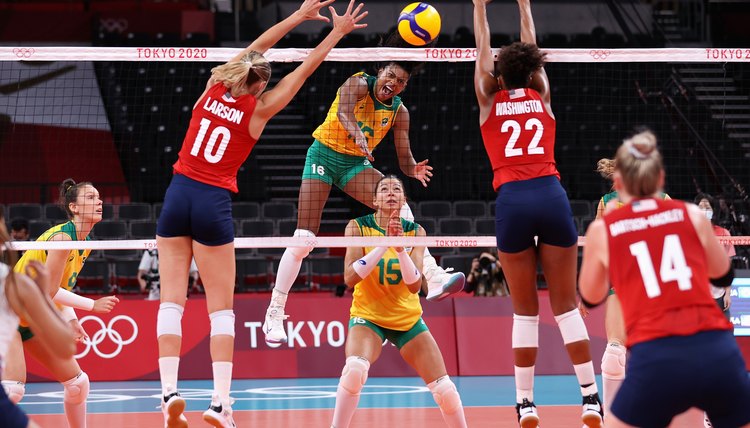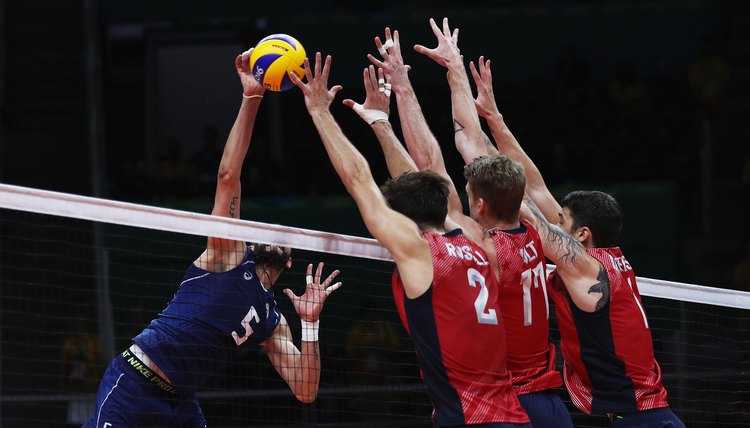What Is a Set Point in Volleyball?

Volleyball is one of the most popular sports in the United States, with large numbers of both male and female competitors across all age groups who compete in indoor volleyball and beach volleyball every day.
Both a men’s and women’s Olympic sport, volleyball uses a unique scoring system with rules set forth by the sport’s world governing body, the International Volleyball Federation (FIVB), and USA Volleyball, which oversees volleyball rules for the sport played within the US, especially at the beginner and high school levels.
Volleyball Sets
Under FIVB rules, a regulation volleyball match is played to the best of five sets; the first team to win three sets wins the match, with the fifth set acting as the tiebreaker if there is no winning team after two sets. USA Volleyball allows tournaments to shorten matches to best two out of three, with the third set acting as the tiebreaker if needed.
Unlike tennis where a set is made up of several games, a set in volleyball is essentially a single volleyball game made up of several rallies. A rally begins with a serve from the serving team to the opposing team, and continues until the ball is either out of play or lands in-bounds before it can be returned to the opponent’s side. A team gets one point for winning a rally.
Volleyball Scoring
Before talking about what it takes to win a set, it is important to know how a team can score points in a volleyball match.
In the sport’s rally scoring system, points are scored when:
- The receiving team fails to return the ball to the other side of the court
- The serving team serves the ball into the side of the net
- The ball goes out of bounds, and the team who did NOT hit it out is rewarded the point
- One of the teams commits an infraction or other service error
Each set is played to 25 points, except if the teams are tied at two sets apiece after four sets, or one set apiece after two sets under USA Volleyball’s tournament rules. In these cases, either a 5th set or a 3rd set acts as the deciding set, and is played up to 15 points. To win a set, a team not only has to be the first to reach the required number of points, it must also hold at least a two-point advantage.
For example, if the score in a set is 24-21, then the team in the lead can win if it scores the next point, because it will have 25 points and a two-point lead. On the other hand, if the score is tied 24-24, then the next team to score will hold a lead of only 25-24, meaning it cannot win the set. In this case, the set continues, and the first team to build a two-point advantage is the winner.

Set Points
Whenever a team can win a set by winning the next point, the situation is a “set point.” In the 24-21 example given earlier, the volleyball team with 24 points is in a set-point situation. Even if its opponent won the point, it would still be set point because the score, now 24-22, would still allow it to win on the next point. If the trailing team managed to tie the score at 24, then it wouldn’t be a set point for anyone. But the winner of the next point would be up 25-24, and it would be set point for that team.
There’s no limit to how many set points there can be in a set, just as there is no limit on how many points a set can have. Beyond 25 -- or 15 in the tiebreaker set -- the teams play until someone has a two-point edge, whether that’s 26-24, 30-28 or 120-118.
Match Point
A related concept is the match point. When a team could win not only the set but also the match with the next point, it’s a match-point situation. Say a team leads a match two sets to one and builds a 24-15 lead in the fourth and final set. It would be match point for that team -- and it would continue to be match point on every point until the other team tied the score.
Volleyball Positions
- Setter: Setters act as passers and ‘set’ the ball up for their teammates to be spiked down into the opponent’s territory
- Outside hitter: The outside hitter is the lead attacker on a team’s offense, acting as the spiker who hits the ball directly into the opponent’s territory with great strength
- Middle blocker: Often the tallest player on the team, the middle blocker acts as the first line of defense against opposing team’s hitters
- Libero: Liberos can only play in the back row, and their main job is to receive hits from the opposing team and create opportunities for their team to set up a spike
References
Writer Bio
Cam Merritt is a writer and editor specializing in business, personal finance and home design. He has contributed to USA Today, The Des Moines Register and Better Homes and Gardens"publications. Merritt has a journalism degree from Drake University and is pursuing an MBA from the University of Iowa.
